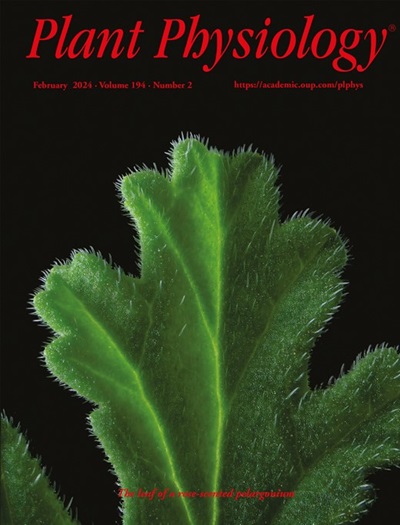转录因子REM16a通过激活与开花相关的基因来促进大豆的开花时间
IF 6.9
1区 生物学
Q1 PLANT SCIENCES
引用次数: 0
摘要
大豆的花期[甘氨酸max (L.)]稳定。]对光周期极为敏感,这在很大程度上影响了其产量潜力,并将大豆品种的地理范围限制在特定的纬度。调控开花时间和降低日照敏感性的分子育种是提高大豆适应性和生产力的有效途径。本文研究了AP2/ b3样转录因子家族成员生殖分生组织16a (GmREM16a)。GmREM16a蛋白含有两个B3结构域,其编码基因的表达对光周期和昼夜节律有响应。GmREM16a在大豆中过表达通过调控开花相关基因的表达而加速开花。GmREM16a蛋白能够直接结合GmSOC1、GmFT2a和GmFT5a的启动子并上调其表达。酵母双杂交筛选发现GmCSN5与GmREM16a相互作用。GmCSN5是COP9信号体(组成型光形态发生信号体,CSN)的第五个亚基,它调节CULLIN-RING E3泛素连接酶的活性并调节蛋白质降解。体内和体外蛋白质降解实验表明,GmCSN5通过泛素-蛋白酶体途径促进GmREM16a蛋白的降解。综上所述,这些发现表明转录因子GmREM16a通过调节开花相关基因的表达来促进开花。此外,GmCSN5与GmREM16a相互作用调节其在大豆中的稳定性。GmREM16a-GmSCN5模块可能是参与大豆开花时间调控的途径,是通过分子育种方法提高大豆适应性的有用遗传资源。本文章由计算机程序翻译,如有差异,请以英文原文为准。
The transcription factor REM16a promotes flowering time in soybean by activating flowering-related genes
The flowering time of soybean [Glycine max (L.) Merr.] is extremely sensitive to photoperiod, which importantly influences its yield potential and restricts the geographical range of soybean cultivars to specific latitudes. Molecular breeding to modulate flowering time and reduce sensitivity to daylength is an effective approach to enhance the adaptability and productivity of soybean. Here, we characterized reproductive meristem 16a (GmREM16a), a member of the AP2/B3-like transcription factor family. The GmREM16a protein contains two B3 domains, and the expression of its encoding gene is responsive to photoperiod and circadian rhythm. Overexpression of GmREM16a in soybean accelerated flowering by regulating the expression of flowering-related genes. The GmREM16a protein was able to directly bind to the promoters of GmSOC1, GmFT2a, and GmFT5a and up-regulate their expression. Yeast two-hybrid screening revealed GmCSN5 interacts with GmREM16a. GmCSN5 is the fifth subunit of the COP9 signalosome (constitutively photomorphogenic signalosome, CSN) that regulates the activity of CULLIN-RING E3 ubiquitin ligases and regulates protein degradation. Protein degradation assays in vivo and in vitro showed that GmCSN5 promotes the degradation of GmREM16a protein via the ubiquitin-proteasome pathway. Taken together, these findings indicate that the transcription factor GmREM16a promotes flowering by regulating the expression of flowering-related genes. Additionally, GmCSN5 interacts with GmREM16a to regulate its stability in soybean. The GmREM16a-GmSCN5 module may represent a pathway involved in the regulation of flowering time in soybean and is a useful genetic resource for improving the adaptability of soybean through molecular breeding approaches.
求助全文
通过发布文献求助,成功后即可免费获取论文全文。
去求助
来源期刊

Plant Physiology
生物-植物科学
CiteScore
12.20
自引率
5.40%
发文量
535
审稿时长
2.3 months
期刊介绍:
Plant Physiology® is a distinguished and highly respected journal with a rich history dating back to its establishment in 1926. It stands as a leading international publication in the field of plant biology, covering a comprehensive range of topics from the molecular and structural aspects of plant life to systems biology and ecophysiology. Recognized as the most highly cited journal in plant sciences, Plant Physiology® is a testament to its commitment to excellence and the dissemination of groundbreaking research.
As the official publication of the American Society of Plant Biologists, Plant Physiology® upholds rigorous peer-review standards, ensuring that the scientific community receives the highest quality research. The journal releases 12 issues annually, providing a steady stream of new findings and insights to its readership.
 求助内容:
求助内容: 应助结果提醒方式:
应助结果提醒方式:


